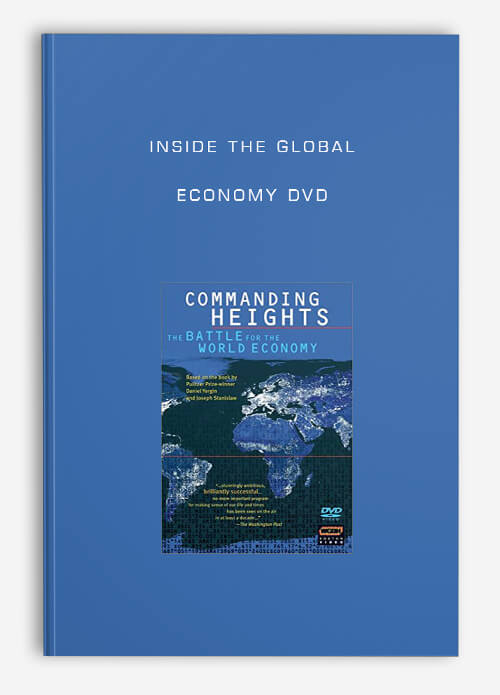Inside the Global Economy DVD
$389.00 $62.00
Product Include:
File size:
Inside the Global Economy DVD
**More information:
Get Inside the Global Economy DVD at Salaedu.com
Description
A video instructional series on economics for college and high school classrooms and adult learners; 13 one-hour video programs and coordinated books
Now on DVD
Created by an international team, this series offers a multinational perspective on how the global economy and market affect individuals, businesses, and industry. The series features 26 case studies, with follow-up analysis, from more than 20 countries, balancing widely held American views with opinions from around the globe and allowing comparison of the strategies used in international economics today.
1. Trade — An Introduction
Why nations trade and what determines trade’s basis and direction. Case studies: IBM’s computer production in Japan; Australia’s mineral export boom and domestic car production.
VOD2. Protectionism vs. Free Trade
Tariff and nontariff trade barriers and the beneficiaries of protectionism. Case studies: French agricultural subsidies and conflict in the Uruguay Round; voluntary export restraints on Japanese cars into the U.S.
VOD3. Trade Policy
Subsidies, regulatory policies, import-competing, and export-promotion. Case studies: Airbus; the Chilean wine industry.
VOD4. Trade Liberalization and Regional Trade Blocs
Multilateral trade liberalization and preferential trading arrangements. Case studies: the Canadian-U.S. Free Trade Agreement; the U.K.’s entry into the EC. Updated 2003.
VOD5. Labor and Capital Mobility
The mobility of capital, labor, and technology, including what drives and inhibits labor migration. Case studies: guest workers in the Netherlands; Mexican immigration to the U.S. and maquiladoras.
VOD6. Multinational Corporations
How capital moves, transfer technology, and the surrounding controversies. Case studies: investment by Ericsson in Hungary; a comparison of Smith-Corona and Brother.
VOD7. Fixed vs. Floating Exchange Rates
The strengths and weaknesses of each type of rate, along with their role as shock absorbers. Case studies: Komatsu vs. Caterpillar; petrodollar recycling in the 1970s.
VOD8. Managing Currencies and Policy Coordination
What motivates governments to manage currencies and coordinate policies. Case studies: the Plaza and Louvre Accords; the cost to the U.K. of joining the European Monetary System.
VOD9. Exchange Rates, Capital Flight, and Hyperinflation
How international capital flows, inflation, and trade flows affect exchange rates. Case studies: Mexico and the money center banks; hyperinflation in Argentina. Updated 2003.
VOD10. Developing Countries
How these nations have been helped or hurt by the rapid growth since WWII. Case studies: comparing South Korea and Sri Lanka; aid vs. trade in Tanzania.
VOD11. Economies in Transition
Transforming former Communist countries into market economies. Case studies: state industries vs. private entrepreneurs in Russia; the success of Poland’s “shock therapy.”
VOD12. Environment
Transnational pollution and international property rights. Case studies: the U.S.-Mexico agreement on dolphin-safe tuna fishing; trans-national pollution along the Rhine River.
VOD13. The Evolving World Economy
The importance of human capital and the shift away from manufacturing to services and knowledge-intensive industries. Case studies: the rise of East Asia, especially China; Microsoft and U.S. dominance of the software market. Updated 2003.
Internet Marketing Course
Digital marketing is the component of marketing that utilizes internet and online based digital technologies such as desktop computers,
mobile phones and other digital media and platforms to promote products and services. Its development during the 1990s and 2000s,
changed the way brands and businesses use technology for marketing. As digital platforms became increasingly incorporated into marketing plans and everyday life,
and as people increasingly use digital devices instead of visiting physical shops, digital marketing campaigns have become prevalent,
employing combinations of search engine optimization (SEO), search engine marketing (SEM), content marketing, influencer marketing, content automation,
campaign marketing, data-driven marketing, e-commerce marketing, social media marketing, social media optimization, e-mail direct marketing, display advertising,
e–books, and optical disks and games have become commonplace. Digital marketing extends to non-Internet channels that provide digital media, such as television,
mobile phones (SMS and MMS), callback, and on-hold mobile ring tones. The extension to non-Internet channels differentiates digital marketing from online marketing.
1 review for Inside the Global Economy DVD
Add a review Cancel reply
Related products
Internet Marketing Courses
Internet Marketing Courses
Internet Marketing Courses
Internet Marketing Courses
Shop of Moxie – The 2015 Six Appeal Process from Ash Ambirge
Internet Marketing Courses
RazorSocial’s – Blogging Blueprint for Success presented by Ian Cleary
Internet Marketing Courses



![Copy Hackers [Joanna Wiebe] – Email Copywriting](https://tradersoffer.forex/wp-content/uploads/2017/02/Copy-Hackers-Joanna-Wiebe-–-Email-Copywriting-220x306.jpg)







king –
We encourage you to check Content Proof carefully before paying.“Excepted” these contents: “Online coaching, Software, Facebook group, Skype and Email support from Author.”If you have enough money and feel good. We encourage you to buy this product from the original Author to get full other “Excepted” contents from them.Thank you!